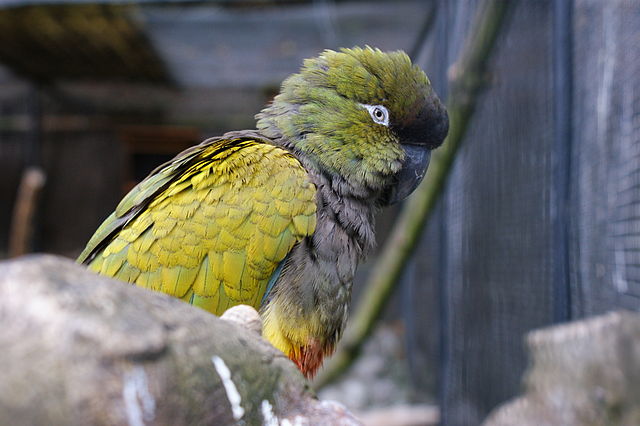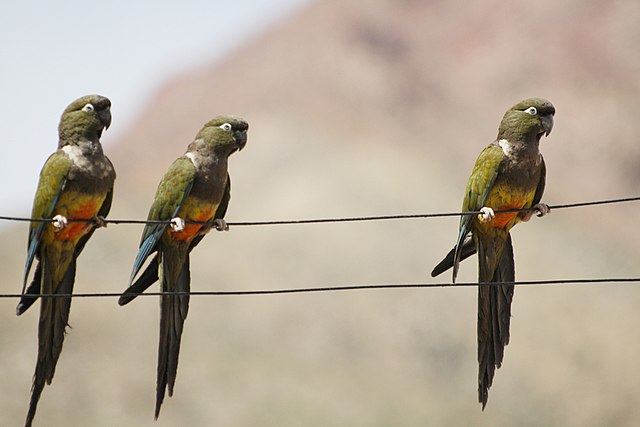The Patagonian Conure (Cyanoliseus patagonus), also known as the “Patagonian Parakeet” is a medium-sized species of parrot that belongs to the genus Cyanoliseus in the family Psittacidae. It is native to the Patagonia region of Argentina and Chile, where it can be found in a variety of habitats, including forests, woodlands, and scrublands.
In terms of physical characteristics, the Patagonian Conure typically measures around 40cm in length and weighs between 250-300 grams. It has a long tail and a relatively large, curved beak, adapted for cracking seeds and nuts. The plumage is primarily green, with blue-green on the head, red-orange on the shoulders, and a blue-green tail. The underwing coverts are yellow, and the flight feathers are blue-green.

In terms of behavior and ecology, Patagonian Conures are social and gregarious birds, often found in flocks of up to 50 individuals. They are active and playful, known to engage in aerial acrobatics and foraging behaviors. They have a wide vocal range and are known for their loud calls and screeches. They feed on a variety of seeds, fruits, and nuts, and have been observed using tools to obtain food. They are active during the day and are roosting at night.
In terms of conservation status, the Patagonian Conure is considered a near-threatened species, due to habitat loss and illegal trapping for the pet trade. The population in the wild is declining and it’s important to ensure that the trade of wild-caught individuals is regulated and that efforts are made to protect and preserve their natural habitats. In captivity, they are known to be hardy and adaptable but require a significant amount of attention and mental stimulation to thrive, they have a lifespan of around 30-40 years with proper care.

How To Stop Patagonian Conures to Screech
Your bird is screeching, the neighbors are complaining, and you just can’t stand the noise any longer. Here are three things that you can do.
- Get used to it…sort of. Patagonian Conures are one of the most vocal of the conure breed, and of any bird in general.
In their natural environment, they live in large flocks where their singing and well…yes screeching is an acceptable and normal means of communication. This natural behavior doesn’t leave just because they’re in your home now. Their instincts remain and so too does their tendency to make lots of noise.
However, if you find that your bird is screeching because he is afraid or angry, or because he has become particularly aggressive, then you absolutely must do something about the behavior before it escalates into more bad behaviors like feather plucking, thrashing about his cage, charging, and even biting. We have several options we teach in our training program that show you what to do in this situation!
- Investigate your Patagonian Conure’s environment.
Because Patagonian Conures are social and intelligent birds, they need constant stimulation. This stimulation should come from you in the form of interaction and affection and also from toys that you place in their cage.
Toys are extremely important for all birds but they are especially important for the Patagonian Conure. Your Conure needs to have the ability to learn, interact, and perform as he would in a natural environment. This means choosing toys that provide different textures like leather, wood, and even plastic. You will want the toys to also come in various shapes and sizes and offer different sounds and colors. There are even problem-solving toys that are especially good for the bright Patagonian Conure.
The truth is that your bird won’t play with all the toys that you buy for him. This means that you’ll have to pay attention to what he does and doesn’t play with. Give him a week or two with new toys. If the toy doesn’t show any sign of wear or it hasn’t been moved since you placed it in his cage, he isn’t likely to play with it. Get rid of it, or place it in an area where he must interact with it, like in his tree.
In addition to the need for toys, the location of your bird’s cage may be causing problems. For example, Conures are social birds and prefer to be around the family generally but if he isn’t allowed to sleep their full 10-12 undisturbed hours, then he’re going to be uncomfortable and unhappy.
One solution is to move the cage during sleep hours to a less noisy environment. Another option is to make a ‘bird room’ in your home. There are bird owners who have cut windows from one room into the main room so that the bird could see the family during the day. When nighttime comes, the shades can be drawn and the bird gets to sleep soundly. This isn’t an option for everyone but it works well for many. Additionally, for the owner of a screecher, when your bird begins to screech, you can turn off the lights in the bird room and shut the blinds. This tends to quiet the bird and train them that screeching isn’t acceptable.
- The last and final solution to a screeching Patagonian Conure is to trick-train your bird.
Many people don’t like the idea of trick training because they’re not looking for a bird that performs, they simply want a bird that cohabitates well in the home. I can tell you from years and years of experience and conversations with bird experts around the world, trick training is the key to eliminating negative bird behaviors. Not just screeching but biting too.
Trick training teaches your bird to trust you. It teaches him the rules of the household – mainly that you are the boss. If you don’t establish these rules, then your bird will quickly run your home and your life.
